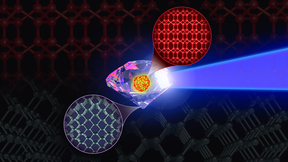National Academies recommend high priority for work on Lawrence Livermore's National Ignition Facility
 (Download Image)
A view from the bottom of the chamber. Pulses from NIF's high-powered lasers race toward the Target Bay at the speed of light. They arrive at the center of the target chamber within a few trillionths of a second of each other, aligned to the accuracy of the diameter of a human hair.
(Download Image)
A view from the bottom of the chamber. Pulses from NIF's high-powered lasers race toward the Target Bay at the speed of light. They arrive at the center of the target chamber within a few trillionths of a second of each other, aligned to the accuracy of the diameter of a human hair.
LIVERMORE, Calif. -- A report issued by the National Research Council highlights the significant impact of successful development of inertial fusion energy (IFE), and recommends priorities for future research in this area.
As noted in this National Academies' report, "The potential benefits of inertial confinement fusion energy (abundant fuel, minimal greenhouse gas emissions, limited high-level radioactive waste requiring long-term disposal) provide a compelling rationale for establishing inertial fusion energy R&D as part of the long-term U.S. energy R&D portfolio."
Research into IFE is a key objective of Lawrence Livermore National Laboratory's National Ignition Facility (NIF) -- the world's premier research facility in this area of science and technology. The NIF was built by the National Nuclear Security Administration (NNSA) primarily to provide data in support of its defense programs, but also has broad applications in basic science and fusion energy.
The National Academies state that "The National Ignition Facility, designed for stockpile stewardship applications, also is of great potential importance for advancing the technical basis for inertial fusion energy (IFE) research," and that the target physics programs on the NIF (and related facilities) "should receive continued high priority."
A near-term goal of the NIF is to demonstrate "ignition," or energy breakeven, which would mark the culmination of more than 50 years of effort and is a principal research pillar of the NNSA's mission.
From the perspective of energy applications, in the view of the Academies, this would be the "appropriate time for the establishment of a national, coordinated, broad-based inertial fusion energy program."
A number of important conclusions and recommendations have been drawn by the Academies on the impact and future direction of this field. They note that there is unanimity among the expert review committees on NIF's potential to achieve ignition. The committee asserts that while NIF has not yet achieved ignition (since its construction in 2009) that does not lessen the long-term technical prospects for IFE. They go further, noting that "[s]o far as target physics is concerned, it is a modest step from NIF scale to IFE scale."
As a result, they recommend that, "planning should begin for making effective use of the National Ignition Facility as one of the major program elements in an assessment of the feasibility of inertial fusion energy." They state that this should include appropriate economic analyses of inertial fusion power plants, within a comprehensive system engineering approach.
Contact
Breanna Bishop[email protected]
925-423-9802
Related Links
National Ignition Facility (NIF)National Academy of Sciences
Tags
National Ignition Facility and Photon ScienceNational Ignition Facility
Lasers and Optical S&T
Lasers
Featured Articles







